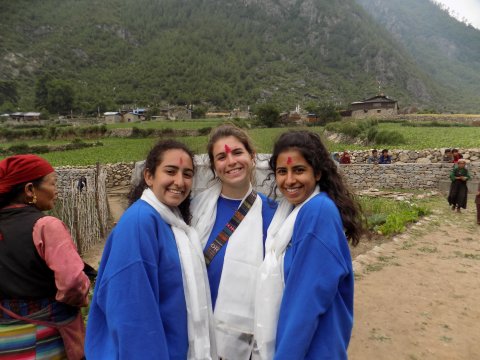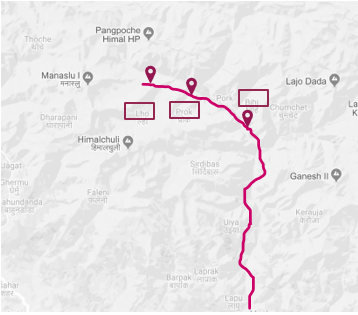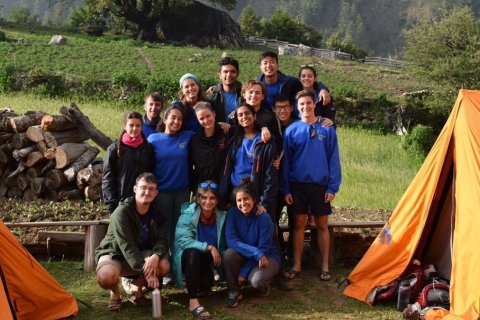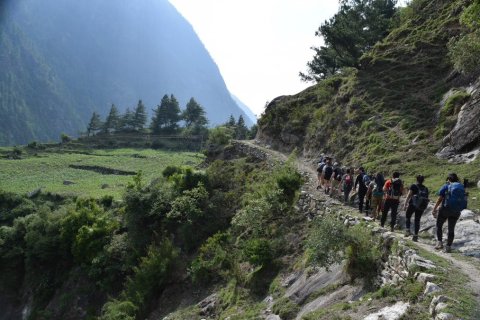On the front line: Period Poverty
Investigating the attitudes and behaviours regarding menstruation in rural Nepal
In 2017, BBC News released a video about a woman called Tricia Chapman1, who has experienced period poverty in the UK. The video shows her struggle of not being able to afford sanitary products each month, resorting to using an old pair of denim jeans as well as socks and tissues. I was shocked by the thought of not being able to afford such an essential product and Tricia’s story made me realise how period poverty is a very real and tangible situation happening here on our doorstep.
Research shows that in 2017, one in ten girls between the ages of 14 and 21 in the UK have been unable to afford sanitary products while 49% have missed a day off school due to periods2. Since then, state schools and colleges in England can now order free period products for students3, which is an amazing step in the journey to end period poverty. However, whilst the issue is only starting to improve here in the UK, period poverty is a global issue, and I travelled across the world to Nepal to see just that.
Chaupadi

Chaupadi is a social tradition that is commonly practiced predominantly in the western regions of Nepal. It originates from a Hindu tradition that considers secretions from menstruation and childbirth as “impure”4. As a result of this, every month, women become untouchable - they must eat separately and make no physical contact with other people or water sources5. In areas where women and girls are isolated in sheds, women have reported being raped or have died of hypothermia or severe bleeding4. Chaupadi was criminalised 2017, whereby anyone who makes a woman observe chaupadi faces a three-month jail sentence and a $27 (£21) fine. Even so, in January 2019, a mother and her two young children died in a menstruation hut in the Bajura district6 and unfortunately this was not a unique case.

In May that same year, myself and 14 other Imperial students travelled from London to Kathmandu to conduct research in the rural villages in the North Ghorka region. After reading about the mother and her children who died under the practice of chaupadi, my group and I were determined to investigate further. We were particularly interested whether there were any differences in attitudes and behaviour regarding menstruation the further the population lived from the capital, Kathmandu. In order to do this, we collaborated with two charities, Community Action Nepal (CAN) and Days for Girls.

CAN is a UK based charity that aims to help the rural villages in Nepal. They do this by empowering the people who live in the mountain regions to help themselves with issues regarding health, education and livelihood. Starting in 1989, CAN has helped deliver over 45 projects in Nepal, including 20 health posts and 15 schools7. We were set to visit three of these health posts during our three-week visit.
Days for Girls International provide health education and quality sustainable menstrual care solutions for girls and young women across the world8. We visited their headquarters in Kathmandu and discussed the current taboo that surrounds menstruation in Nepal, including the practise of chaupadi. As Days for Girls were not yet active in the villages that we were visiting, we collaborated with them to produce a set of questions which would benefit the charity and allow us to complete our study at the same time.
We began our journey with an 8-hour drive to Soti Khola, 126km north west from Kathmandu, which is the starting point for the Manaslu circuit trek. Due to the destruction of many roads in the 2015 earthquake (which had its epicentre in Ghorka), we trekked the rest of our journey, visiting three health posts in the villages of Bihi, Prok and Lho, which were 4, 5 and 6 days of trekking respectively from Soti Khola. At each health post, we conducted multiple group interviews with the help of one of the CAN nurses, who acted as our translator. Men and boys were not involved as we understood the cultural sensitivity around menstruation. In total, we spoke to 55 women with an average age of 37.3 years and an average age of menarche of 15.8 years.

We were able to draw many conclusions from the data we collected. In summary, as remoteness of villages increased, local women’s education and understanding of menstruation decreased. In addition, there was also a decrease in support during menstruation and a parallel increase in reliance on charities for information. However, we acknowledge that each individual’s practice was not always representative of their level of education and understanding; and that due to the small sample size, the data was not completely representative. We also discovered that teenagers did not participate in our study. We attribute this to a phenomenon called Educational Migration, where many young people travel away from their villages to receive further education and opportunities in the cities9.
One of the most significant findings from our study focused on menstrual management. Women in Bihi and Prok reported a heavy reliance on disposable pads. In contrast, one third of women in Lho used reusable cloths, whilst a further third did not use anything. The impact of not using any sanitary product meant that these women were restricted to staying at home and for the young girls in this village staying at home for 5-7 days every month would have negative repercussions on education and eventually their opportunities to get jobs and earn a high income. Our study highlights that villages closer to the capital have a greater level of awareness and education, and so menstruation does not have as great an impact on the lives of women. If charities such as Days for Girls were able to visit villages further away such as Lho, they would be able to support the girls and women through education and sustainable skills, such as how to make their own reusable cloths.
Our study highlights just one of the problems that exists in rural Nepal regarding menstruation behaviours and the lasting impact this can have on one’s future. It also reinforces that education on menstruation is just as important as the accessibility of sanitary products and is a vital part of the story if we are to end period poverty by 2030.
Acknowledgements:
I would like to thank my group, Daniella Boules and Carmen Thompson Perea, our supervisors Prof. Steve Gentleman and Dr Tamlyn Peel and the charities we collaborated with, Days for Girls, Community Action Nepal and Community Action Trek.
References:
BBC News. Surviving Period Poverty with ‘Socks and Tissue’. 2017. Available from: https://www.youtube.com/watch?v=K6fYLq7O0j4 [17.03.2020]
Plan International UK. Plan UK’s Research on Period Poverty and Stigma. 2017. Available from: https://plan-uk.org/media-centre/plan-international-uks-research-on-peri...
Shearing H; BBC News. Period Poverty: Schools urged to order free menstrual products. 2020. Available from: https://www.bbc.co.uk/news/uk-51167487?intlink_from_url=htps://www.bbc.c...
Shelley A, Gaestel A; Pulitzer Center. Chaupadi: Nepali Women’s Monthly Exile. 2012. Available from: https://pulitzercenter.org/projects/nepal-cultural-practice-women-childb...
Robinson H. Chaupadi: The Affliction of Menses in Nepal. International Journal of Women’s Dermatology. 2015; 1(4): 193–194. Available from: doi: 10.1016/j.ijwd.2015.10.002
BBC News. Nepal Woman and Children Die In Banned ‘Menstruation Hut’. 2019. Available from: https://www.bbc.co.uk/news/world-asia-46823289 [18.03.2020]
CANEPAL. Community Action Nepal. Available from: https://www.canepal.org.uk [20.03.20]
DaysForGirls. Days for Girls International- Turning Periods into Pathways. Availabe from: https://www.daysforgirls.org [18.03.2020]
Childs G, Choedup N. From a Trickle to a Torrent. California: University of California Press; 2019.